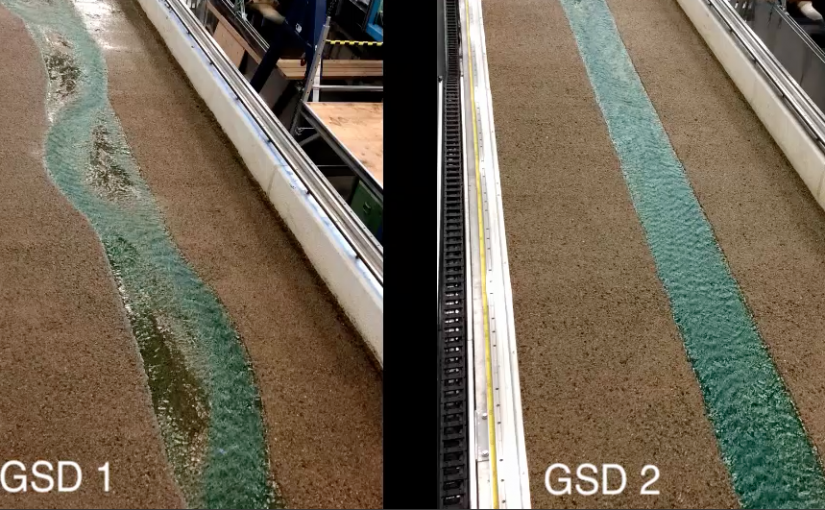We recently ran a pair of experiments that demonstrates that channel stability is independent of the mobility of the surface median grain size (D50). The video above shows a time lapse for the two experiments. In both cases, the median grain size was fully mobile. However the largest sediment in the bed was fully mobile for one experiment (the one on the left) but only partially mobile for the other experiment (the one on the right). We analyzed these two experiments, and the results are presented in a paper recently accepted by Earth Surface Processes and Landforms.
We think the implications of this pair of experiments are potentially quite profound. While using the D50 as the characteristic size for analyzing sediment entrainment and transport seems quite reasonable, we cannot make the tempting (though facile) assumption that the stability of a channel is associated with either the entrainment of the D50, or with full mobility of that size class. However, we do seem to be able to associate periods of significant net change in reach-average geometry and channel pattern with full mobility of the largest sediment sizes in the bed material.
One implication of this is that bed stability (and channel morphodynamics) may be fundamentally controlled by the entrainment and transport of the largest grains on the channel bed, as is commonly assumed to be true for step-pool streams. Interestingly, many flow resistance laws have found a stronger correlation between mean velocity and a roughness measure based on grains larger than the D50 (like the 84th percentile of the surface grain size distribution), which may be linked to the role such grains play in stabilizing the channel bed.
Another implication is that small additions of coarser than average material may substantially alter gravel bed channel morphodynamics, promoting a more stable stream with a much lower bedload transport rate for a given flow. This fact could be exploited to develop new restoration techniques that do not rely on heavy handed engineering approaches. Conversely, removing a small fraction of the coarse tail of the bed material could dramatically increase the lateral activity of a stream, which could be exploited to help restore natural channel dynamics where flow regulation and development on the floodplain places a limit on the size of floods that can be released to the stream.
Related Work
This paper by Masteller and Finnegan (2017) points out the significant role that bed state and grain protrusion play in controlling sediment transport rate, and could be closely related to our findings.
This research spotlight points out the role that large grains play in mediating sediment transport in steep streams.

I agree fully with your conclusions.
There exists an old research in Italy bringing to comparable practical outcomes. I have also carried out experiments with random boulder cover of the bed and the bedload rate greatly reduces.
This is really interesting to me. Can you post a link to those papers so that others looking at this blog can easily find their way to your work as well?